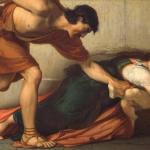Pierre-Simon Ballanche (1776-1847) is hardly a household name today, but he was a significant literary figure in 19th-century France. Albert Joseph George calls him a “precursor to romanticism,” and he was an eccentrically Christian advocate for social reforms of various kinds. In his Ville des expiations, unpublished in his lifetime, he laid out a vision for prison reform that rejected utilitarian defense of punishment.
As George observes, Ballanche always had an affinity for victims: “He had never vaunted the executioner like de Maistre. His heroes had always been victims: Orpheus, Antigone, Ines de Caster, Jeanne d’Arc, and Louis XVI” (151).
This attention to victims should be embodied in social order as an expression of the penetration of the gospel into society: “progress meant the abolition of caste, a struggle in which the people, the active principle, defeated the aristocracy, the passive principle. The social greatness of Christianity was that it established a religious equality from which must inevitably spring civic equality” (151-2).
His work on prison reform was part of his long-term reflection on the problem of evil. He aimed “to conciliate the doctrine of the inviolability of human life with that to the security of society” (152). To achieve this double aim, he proposed the formation of a city for the rehabilitation of criminals. It consisted of two sections “an outer one for the rehabilitation of criminals, and an inner one to house a college of priests skilled in judging quarrels between nations, or between governments and their peoples” (152).
The text is a Utopia, told in fictional form, as Ballanche describes a visit to the city of expiation. The high city (Ville Haute) is ruled by a dictator whose decrees are interpreted by a High Court, divided into sections that determine cases for each of the five sections of the population – “neophytes, colonists, guards, soldiers, or savants.” Soldiers guard the town, a commercial section is open from dawn to dusk. The upper city includes “vast hospitals, a seminary, and a normal school for prison wardens:” (153).
The low city is inhabited by neophytes, criminals, who “come for voluntary expiation.” George describes its form: “Composed of twelve parishes or sixty villages collectively entitled le Desert, it is divided mathematically in an almost mystic respect for numbers. Each village contains sixty houses, all in the form of tents. There is one room to a house, one person to a room, and one book for each inhabitant, the Manuel du chrstien. Every night the prisoners are locked in; each week lots are drawn to determine the village and house to be occupied. The sexes live separately, though age groups are kept together. The city sparkles in its cleanliness and, since even talk of politics and war is forbidden, quiet hangs over its many lawns and gardens” (153).
In the low city, the neophytes move through a ritually-structured series of re-initiations: “When a man is condemned to the city, he appears for initiation in the manner of the ancients. Received in a black robe, covered with chains, he hears a catalogue of his crimes. The fetters are then removed and the rules explained. For thirty days, the convict stays in a prison called le tombeau, then is led out to be washed and clothed in a white robe. A new life begins, for which he is provided a new name and age. The prisoner is warned never to reveal his identity under pain of punishment and the dictator begins a weekly account of his actions. . . . Once inside the colony, a neophyte can communicate with the outside world. His mail undergoes censorship, but only for his own protection. He can study, too, if he so desires, except that no science is permitted without the express permission of the masters of science, no truth promulgated without the consent of the teachers” (153-4).
George, understatedly, says that the city is run with “a find degree of standardization. Each prison must bathe every two weeks, guards keep the smell down by spread perfume around the city. Life is “accompanied by music; there are concerts even in the middle of the night” (154), perhaps on the assumption that music will help to re-tune the souls of the prisoners.
As they progress, neophytes move from one part of the city to another: “If his conduct seems exemplary, a prisoner may leave the villages and become a habitant, that is, own a fixed home. He may also take a wife, though celibacy is generally the rule.” Eventually “he passes to the upper city where he may exercise a profession” and may “own a business or farm: (154).
Neophytes aren’t permanent residents: “When a neophyte complete his expiation and wishes to re-enter the world, the entire city rejoices. At a ceremony, the rehabilitated sinner regains his name.” Those who fail to repent are buried in the city under their assume name (155).
Ballanche’s reforms broke radically with French criminal law: “For centuries, France had clung to a penal system based on the maintenance of class privilege. The clergy and nobility punished evil-doers as a threat to their own security. A maze of courts ground out sentences of appalling barbarity, not with the intent to reform, but to strike bleak terror into any who dared tamper with the status quo. Executions became public festivals and criminals were maimed and tortured for the slightest breach of the law” (156).
Under the circumstances, it’s not surprising that Ballanche would propose a reform that attempted to embody the dignity of the criminal and Christian mercy. Yet one cannot help be reminded of C. S. Lewis’s penetrating comment that “good men (not bad men) consistently acting upon [Humanitarian principles] would act as cruelly and unjustly as the greatest tyrants. They might in some respects act even worse. Of all tyrannies a tyranny sincerely exercised for the good of its victims may be the most oppressive.”












